Establishing a baseline is essential on any time series forecasting problem.
A baseline in performance gives you an idea of how well all other models will actually perform on your problem.
In this tutorial, you will discover how to develop a persistence forecast that you can use to calculate a baseline level of performance on a time series dataset with Python.
After completing this tutorial, you will know:
- The importance of calculating a baseline of performance on time series forecast problems.
- How to develop a persistence model from scratch in Python.
- How to evaluate the forecast from a persistence model and use it to establish a baseline in performance.
Kick-start your project with my new book Time Series Forecasting With Python, including step-by-step tutorials and the Python source code files for all examples.
Let’s get started.
- Updated Apr/2019: Updated the link to dataset.

How to Make Baseline Predictions for Time Series Forecasting with Python
Photo by Bernard Spragg. NZ, some rights reserved.
Forecast Performance Baseline
A baseline in forecast performance provides a point of comparison.
It is a point of reference for all other modeling techniques on your problem. If a model achieves performance at or below the baseline, the technique should be fixed or abandoned.
The technique used to generate a forecast to calculate the baseline performance must be easy to implement and naive of problem-specific details.
Before you can establish a performance baseline on your forecast problem, you must develop a test harness. This is comprised of:
- The dataset you intend to use to train and evaluate models.
- The resampling technique you intend to use to estimate the performance of the technique (e.g. train/test split).
- The performance measure you intend to use to evaluate forecasts (e.g. mean squared error).
Once prepared, you then need to select a naive technique that you can use to make a forecast and calculate the baseline performance.
The goal is to get a baseline performance on your time series forecast problem as quickly as possible so that you can get to work better understanding the dataset and developing more advanced models.
Three properties of a good technique for making a baseline forecast are:
- Simple: A method that requires little or no training or intelligence.
- Fast: A method that is fast to implement and computationally trivial to make a prediction.
- Repeatable: A method that is deterministic, meaning that it produces an expected output given the same input.
A common algorithm used in establishing a baseline performance is the persistence algorithm.
Stop learning Time Series Forecasting the slow way!
Take my free 7-day email course and discover how to get started (with sample code).
Click to sign-up and also get a free PDF Ebook version of the course.
Persistence Algorithm (the “naive” forecast)
The most common baseline method for supervised machine learning is the Zero Rule algorithm.
This algorithm predicts the majority class in the case of classification, or the average outcome in the case of regression. This could be used for time series, but does not respect the serial correlation structure in time series datasets.
The equivalent technique for use with time series dataset is the persistence algorithm.
The persistence algorithm uses the value at the previous time step (t-1) to predict the expected outcome at the next time step (t+1).
This satisfies the three above conditions for a baseline forecast.
To make this concrete, we will look at how to develop a persistence model and use it to establish a baseline performance for a simple univariate time series problem. First, let’s review the Shampoo Sales dataset.
Shampoo Sales Dataset
This dataset describes the monthly number of shampoo sales over a 3 year period.
The units are a sales count and there are 36 observations. The original dataset is credited to Makridakis, Wheelwright, and Hyndman (1998).
Below is a sample of the first 5 rows of data, including the header row.
|
1 2 3 4 5 6 |
"Month","Sales" "1-01",266.0 "1-02",145.9 "1-03",183.1 "1-04",119.3 "1-05",180.3 |
Below is a plot of the entire dataset where you can download the dataset and learn more about it.
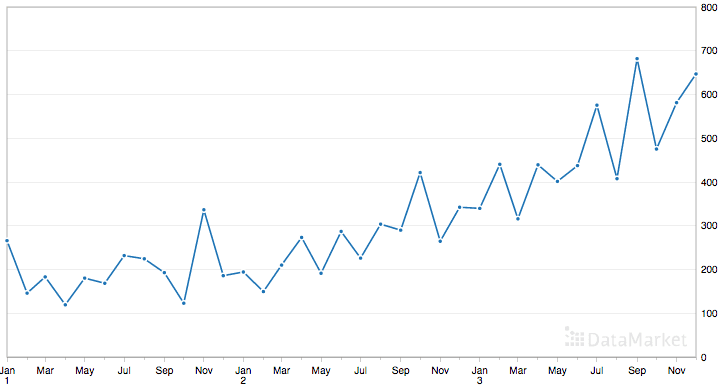
Shampoo Sales Dataset
The dataset shows an increasing trend, and possibly some seasonal component.
Download the dataset and place it in the current working directory with the filename “shampoo-sales.csv“.
The following snippet of code will load the Shampoo Sales dataset and plot the time series.
|
1 2 3 4 5 6 7 8 9 10 |
from pandas import read_csv from pandas import datetime from matplotlib import pyplot def parser(x): return datetime.strptime('190'+x, '%Y-%m') series = read_csv('shampoo-sales.csv', header=0, parse_dates=[0], index_col=0, squeeze=True, date_parser=parser) series.plot() pyplot.show() |
Running the example plots the time series, as follows:
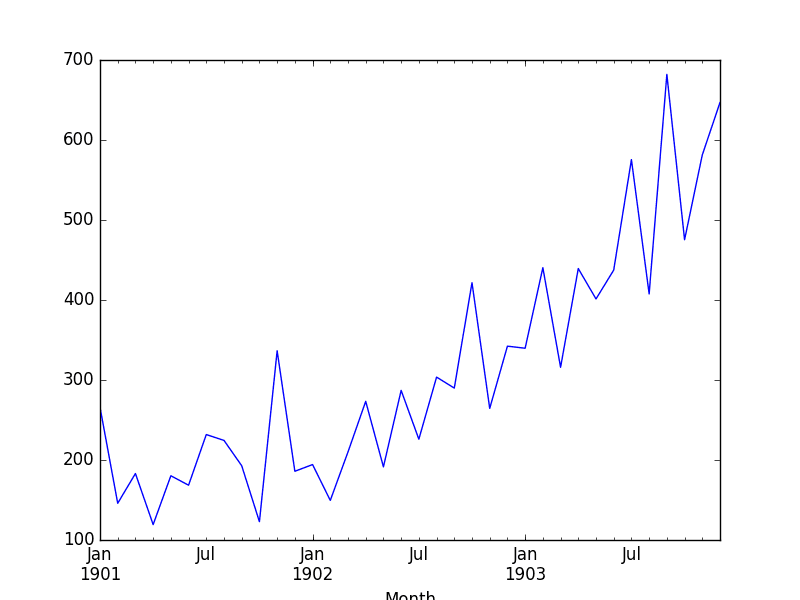
Shampoo Sales Dataset Plot
Persistence Algorithm
A persistence model can be implemented easily in Python.
We will break this section down into 4 steps:
- Transform the univariate dataset into a supervised learning problem.
- Establish the train and test datasets for the test harness.
- Define the persistence model.
- Make a forecast and establish a baseline performance.
- Review the complete example and plot the output.
Let’s dive in.
Step 1: Define the Supervised Learning Problem
The first step is to load the dataset and create a lagged representation. That is, given the observation at t-1, predict the observation at t+1.
|
1 2 3 4 5 |
# Create lagged dataset values = DataFrame(series.values) dataframe = concat([values.shift(1), values], axis=1) dataframe.columns = ['t-1', 't+1'] print(dataframe.head(5)) |
This snippet creates the dataset and prints the first 5 rows of the new dataset.
We can see that the first row (index 0) will have to be discarded as there was no observation prior to the first observation to use to make the prediction.
From a supervised learning perspective, the t-1 column is the input variable, or X, and the t+1 column is the output variable, or y.
|
1 2 3 4 5 6 |
t-1 t+1 0 NaN 266.0 1 266.0 145.9 2 145.9 183.1 3 183.1 119.3 4 119.3 180.3 |
Step 2: Train and Test Sets
The next step is to separate the dataset into train and test sets.
We will keep the first 66% of the observations for “training” and the remaining 34% for evaluation. During the split, we are careful to exclude the first row of data with the NaN value.
No training is required in this case; it’s just habit. Each of the train and test sets are then split into the input and output variables.
|
1 2 3 4 5 6 |
# split into train and test sets X = dataframe.values train_size = int(len(X) * 0.66) train, test = X[1:train_size], X[train_size:] train_X, train_y = train[:,0], train[:,1] test_X, test_y = test[:,0], test[:,1] |
Step 3: Persistence Algorithm
We can define our persistence model as a function that returns the value provided as input.
For example, if the t-1 value of 266.0 was provided, then this is returned as the prediction, whereas the actual real or expected value happens to be 145.9 (taken from the first usable row in our lagged dataset).
|
1 2 3 |
# persistence model def model_persistence(x): return x |
Step 4: Make and Evaluate Forecast
Now we can evaluate this model on the test dataset.
We do this using the walk-forward validation method.
No model training or retraining is required, so in essence, we step through the test dataset time step by time step and get predictions.
Once predictions are made for each time step in the training dataset, they are compared to the expected values and a Mean Squared Error (MSE) score is calculated.
|
1 2 3 4 5 6 7 |
# walk-forward validation predictions = list() for x in test_X: yhat = model_persistence(x) predictions.append(yhat) test_score = mean_squared_error(test_y, predictions) print('Test MSE: %.3f' % test_score) |
In this case, the error is more than 17,730 over the test dataset.
|
1 |
Test MSE: 17730.518 |
Step 5: Complete Example
Finally, a plot is made to show the training dataset and the diverging predictions from the expected values from the test dataset.
From the plot of the persistence model predictions, it is clear that the model is 1-step behind reality. There is a rising trend and month-to-month noise in the sales figures, which highlights the limitations of the persistence technique.
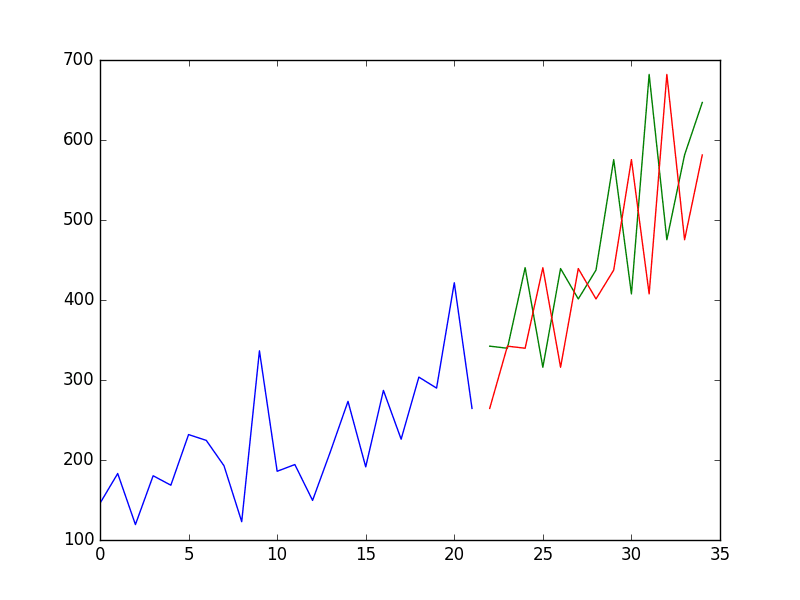
Shampoo Sales Persistence Model
The complete example is listed below.
|
1 2 3 4 5 6 7 8 9 10 11 12 13 14 15 16 17 18 19 20 21 22 23 24 25 26 27 28 29 30 31 32 33 34 35 36 37 38 39 40 41 |
from pandas import read_csv from pandas import datetime from pandas import DataFrame from pandas import concat from matplotlib import pyplot from sklearn.metrics import mean_squared_error def parser(x): return datetime.strptime('190'+x, '%Y-%m') series = read_csv('shampoo-sales.csv', header=0, parse_dates=[0], index_col=0, squeeze=True, date_parser=parser) # Create lagged dataset values = DataFrame(series.values) dataframe = concat([values.shift(1), values], axis=1) dataframe.columns = ['t-1', 't+1'] print(dataframe.head(5)) # split into train and test sets X = dataframe.values train_size = int(len(X) * 0.66) train, test = X[1:train_size], X[train_size:] train_X, train_y = train[:,0], train[:,1] test_X, test_y = test[:,0], test[:,1] # persistence model def model_persistence(x): return x # walk-forward validation predictions = list() for x in test_X: yhat = model_persistence(x) predictions.append(yhat) test_score = mean_squared_error(test_y, predictions) print('Test MSE: %.3f' % test_score) # plot predictions and expected results pyplot.plot(train_y) pyplot.plot([None for i in train_y] + [x for x in test_y]) pyplot.plot([None for i in train_y] + [x for x in predictions]) pyplot.show() |
We have seen an example of the persistence model developed from scratch for the Shampoo Sales problem.
The persistence algorithm is naive. It is often called the naive forecast.
It assumes nothing about the specifics of the time series problem to which it is applied. This is what makes it so easy to understand and so quick to implement and evaluate.
As a machine learning practitioner, it can also spark a large number of improvements.
Write them down.
This is useful because these ideas can become input features in a feature engineering effort or simple models that may be combined in an ensembling effort later.
Summary
In this tutorial, you discovered how to establish a baseline performance on time series forecast problems with Python.
Specifically, you learned:
- The importance of establishing a baseline and the persistence algorithm that you can use.
- How to implement the persistence algorithm in Python from scratch.
- How to evaluate the forecasts of the persistence algorithm and use them as a baseline.
Do you have any questions about baseline performance, or about this tutorial?
Ask your questions in the comments below and I will do my best to answer.

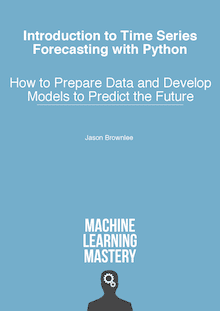




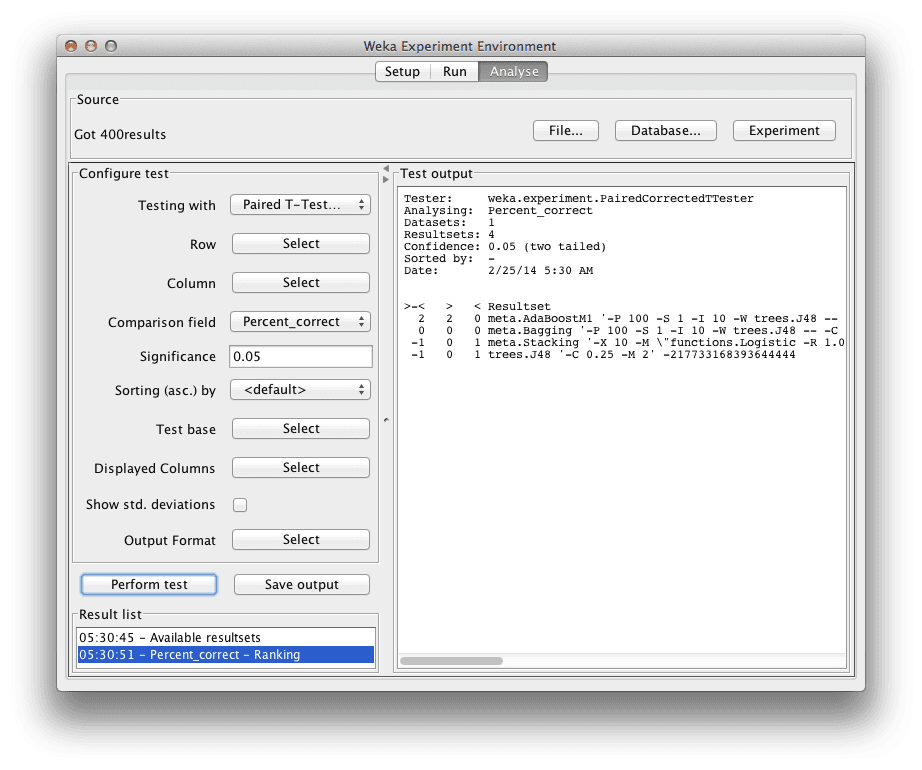
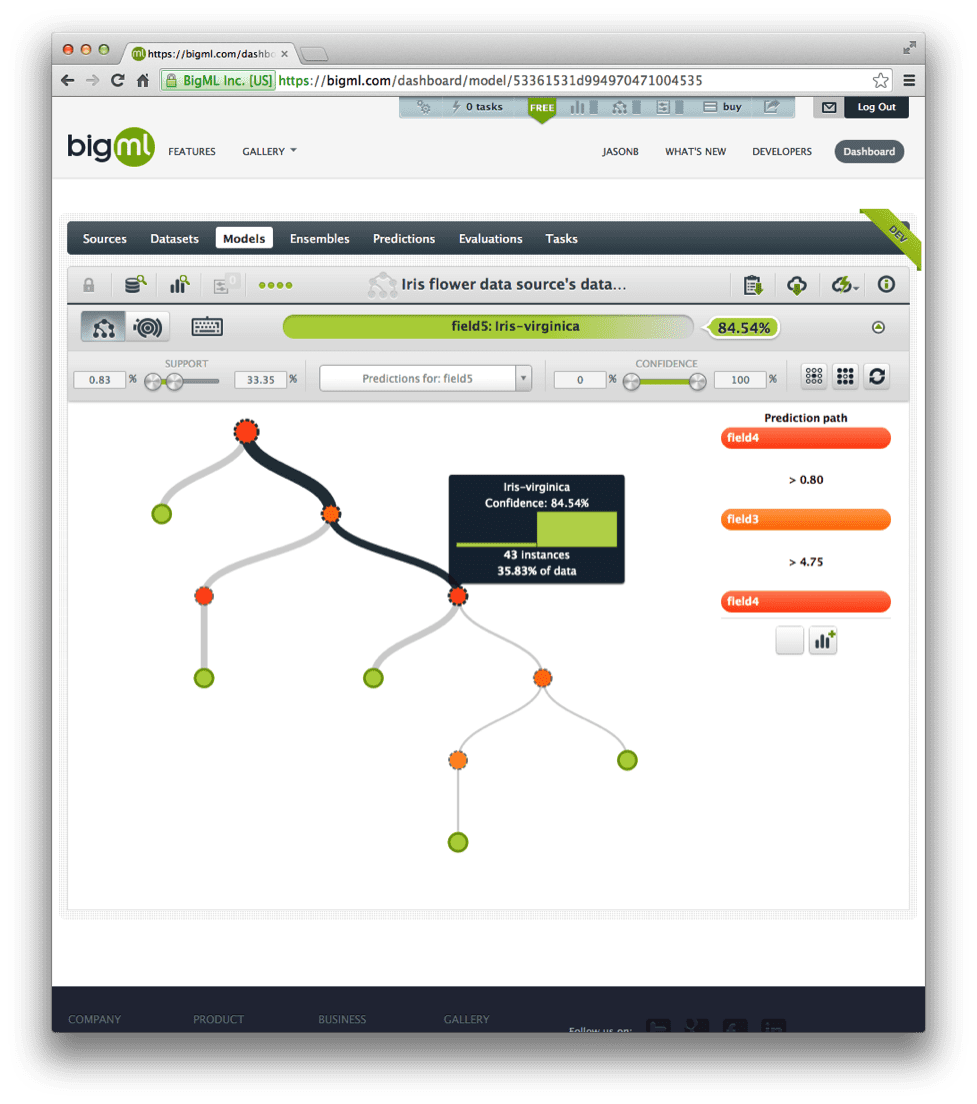
Great post. However, I think instead of (t-1) and (t+1), it should be (t) and (t+1). The former indicates a lag of 2 time steps; the persistence model only requires a 1 step look-back.
That would be clearer, thanks Kevin.
Any suggestion how to implement this?
Is it only a question of column declarations?
dataframe.columns = [‘t-1’, ‘t+1’] vs. dataframe.columns = [‘t’, ‘t+1’]
…or do I have to change some more code logic?
Great post!
Thanks Ansh.
Creating a forecast for a baseline. The hard part of baselines is, of course, the future. How good are economists or meteorologists at predicting the stock market or weather? Uncertainty is an unavoidable part of this part of the work.
Yes, not sure I follow. Perhaps you could restate your point?
Hello, I have a question.
Quote: “If a model achieves performance at or below the baseline,
..the technique should be fixed or abandoned”
Where is the baseline in the plot?
What does it mean at or below the baseline in regard of the example plots?
What does the red and the green line describe?
I assume:
blue line = training data
green line = test data
red line = prediction
Am I right?
I’m not afraid to ask stupid questions. I’ve studied a lot and know no one knows everything :-).
Here, baseline is the model you have chosen to be the baseline. E.g. a persistence forecast.
So then I have to compare the MSE-values of the baseline model and a chosen model
to decide whether my chosen model is the right model to predict something.
The performance of the baseline model is:
Test Score: 17730.518 MSE
I have feeded the shampoo-data into your Multilayer Perceptron-example.
Test A)
The performance of the Multilayer Perceptron Model on the shampoo-data is:
Train Score: 6623.57 MSE
Test Score: 19589.78 MSE
Test Score mlp model: 19589.78 MSE > Test Score baseline model: 17730.518 MSE
Conclusion:
The choosen mlp model predicts something, because its MSE is higher then
the MSE of the baseline model while using the same raw data.
‘There is some significance’.
Is this right so far?
Actually I would expect I higher error rate as bad sign.
Test B)
Airline LSTM Example (feeded with shampoo data):
testScoreMyTest = mean_squared_error(testY[0], testPredict[:,0])
print(‘testScoreMyTest: %.2f MSE’ % (testScoreMyTest))
Test Score Airline LSTM: 20288.20 MSE > Test Score baseline model: 17730.518 MSE
Conclusion:
Airline LSTM Example predicts something on shampoo data.
Here I have a problem. I wanted to see if user Wollner is right.
https://machinelearningmastery.com/time-series-prediction-lstm-recurrent-neural-networks-python-keras/#comment-383708
Does the baseline test shows that he isn’t right???
I also try it with RMSE
testScore = math.sqrt(mean_squared_error(test_y, predictions))
print(‘Test Score: %.2f RMSE’ % (testScore))
The smaller the value of the RMSE, the better is the predictive accuracy of the model.
http://docs.aws.amazon.com/machine-learning/latest/dg/regression-model-insights.html
The performance of the baseline model is:
testScore = math.sqrt(mean_squared_error(test_y, predictions))
print(‘Test Score: %.2f RMSE’ % (testScore))
Test Score: 133.16 RMSE
I have feeded the shampoo-data into your Multilayer Perceptron-example.
Test A)
The performance of the Multilayer Perceptron Model on the shampoo-data is:
Test Score: 139.96 RMSE > 133.16 RMSE
Test B)
Airline LSTM Example (feeded with shampoo data):
Test Score: 142.43 RMSE > 133.16 RMSE
Conclusion:
Actually in regard to the Amazon documentation, I would say both models
perform bad compared to the baseline model and therefore they
are NOT professionally qualified to solve the ‘shampoo problem’.
Do I have a misconception here?
The idea is to compare the performance of the baseline model to all other models that you evaluate on your problem.
Regarding MSE, the goal is to minimize the error, so smaller values are better.
I try to use labels in the plot according to http://matplotlib.org/users/legend_guide.html
Example:
pyplot.plot(train_y, label=’Training Data’)
But every time I have to go to options in the plot window and check auto generate labels to view my declarations.
Is this behavior normal?
I am not an expert in matplotlib sorry, but you can style everything about your plots programmatically.
great post, read the whole mini course and i’m now trying to implement it.
any tips on modifying the code to accept multivariate inputs?
Thanks.
I hope to cover multivariate cases in more detail in the future.
Why is there a gap in the persistence model graph in step 5? how to close that gap in graph?
Not sure I follow?
We are plotting different series so they start and end at different places and have different colors.
I guess you can plot whatever you like, such as concatenate the history with the predictions?
Hey Jason
Can you tell how can we get the next month’s forecasted value?
lets say i have a data of n months then how t predict what will be its value in n+1 month?
Yes, see this post:
https://machinelearningmastery.com/make-sample-forecasts-arima-python/
Hey Jason,
Is there a way so set cap and floor while forecasting through ARIMA? It would be useful to avoid erroneous values for a business data.
You can post-process the forecast prior to evaluation.
Yeah I did that. I thought, may be there is a way to pass the bounds as parameters like its possible in Prophet in R. Anyway, thanks Jason 🙂
Hi, Thank you for your good posting! 😀
I read a lot of your articles. I have question, though.
Making predictions, using LSTM, on random walk process(= like stock price) results in baseline prediction.
How can I evade this?
Any suggestions would helpful. Thank you!
Some problems are not predictable, e.g. those that are a random walk.
thanks for your blog, Jason.
even after readied this article, I don’t understand it fully.
according to you, persistence model is not forecasting. the word “prediction” could be not suitable in this topic, isn’t it?
Could you tell; when I obtained a fully matched persistence plot with the raw data plot, what does mean that?
Ju
It is a prediction, just a naive prediction.
Jason, furthermore in this blog,
if I got the completely matched baseline with the raw data plot, I don’t need to apply other models for solving the targeted problem?
Ju
If the persistence model gives zero error, it means your time series is a flat straight line (e.g. has no information).
Otherwise, perhaps you have a bug?
Hello Dr,
I am having to problem with loading the data, It seems I always have issues with data with datetime but cant seem to figure out the issue, I am new to python. hopefully you can help me out as I am loving your website. It seems that the error is in line 6
/usr/local/bin/python3.7 /Users/Brian/PycharmProjects/MachineLearningMasteryTimeSeries1/baselinezerorule.py
Traceback (most recent call last):
File “/Library/Frameworks/Python.framework/Versions/3.7/lib/python3.7/site-packages/pandas/io/parsers.py”, line 3021, in converter
date_parser(*date_cols), errors=’ignore’)
File “/Users/Brian/PycharmProjects/MachineLearningMasteryTimeSeries1/baselinezerorule.py”, line 6, in parser
return datetime.strptime(‘190 ‘ +x, ‘%Y-%m’)
TypeError: strptime() argument 1 must be str, not numpy.ndarray
During handling of the above exception, another exception occurred:
Traceback (most recent call last):
File “/Library/Frameworks/Python.framework/Versions/3.7/lib/python3.7/site-packages/pandas/io/parsers.py”, line 3030, in converter
dayfirst=dayfirst),
File “pandas/_libs/tslibs/parsing.pyx”, line 434, in pandas._libs.tslibs.parsing.try_parse_dates
File “pandas/_libs/tslibs/parsing.pyx”, line 431, in pandas._libs.tslibs.parsing.try_parse_dates
File “/Users/Brian/PycharmProjects/MachineLearningMasteryTimeSeries1/baselinezerorule.py”, line 6, in parser
return datetime.strptime(‘190 ‘ +x, ‘%Y-%m’)
File “/Library/Frameworks/Python.framework/Versions/3.7/lib/python3.7/_strptime.py”, line 577, in _strptime_datetime
tt, fraction, gmtoff_fraction = _strptime(data_string, format)
File “/Library/Frameworks/Python.framework/Versions/3.7/lib/python3.7/_strptime.py”, line 359, in _strptime
(data_string, format))
ValueError: time data ‘190 1-01’ does not match format ‘%Y-%m’
During handling of the above exception, another exception occurred:
Traceback (most recent call last):
File “/Users/Brian/PycharmProjects/MachineLearningMasteryTimeSeries1/baselinezerorule.py”, line 8, in
series = read_csv(‘shampoo-sales.csv’, header=0, parse_dates=[0], index_col=0, squeeze=True, date_parser=parser)
File “/Library/Frameworks/Python.framework/Versions/3.7/lib/python3.7/site-packages/pandas/io/parsers.py”, line 678, in parser_f
return _read(filepath_or_buffer, kwds)
File “/Library/Frameworks/Python.framework/Versions/3.7/lib/python3.7/site-packages/pandas/io/parsers.py”, line 446, in _read
data = parser.read(nrows)
File “/Library/Frameworks/Python.framework/Versions/3.7/lib/python3.7/site-packages/pandas/io/parsers.py”, line 1036, in read
ret = self._engine.read(nrows)
File “/Library/Frameworks/Python.framework/Versions/3.7/lib/python3.7/site-packages/pandas/io/parsers.py”, line 1922, in read
index, names = self._make_index(data, alldata, names)
File “/Library/Frameworks/Python.framework/Versions/3.7/lib/python3.7/site-packages/pandas/io/parsers.py”, line 1426, in _make_index
index = self._agg_index(index)
File “/Library/Frameworks/Python.framework/Versions/3.7/lib/python3.7/site-packages/pandas/io/parsers.py”, line 1504, in _agg_index
arr = self._date_conv(arr)
File “/Library/Frameworks/Python.framework/Versions/3.7/lib/python3.7/site-packages/pandas/io/parsers.py”, line 3033, in converter
return generic_parser(date_parser, *date_cols)
File “/Library/Frameworks/Python.framework/Versions/3.7/lib/python3.7/site-packages/pandas/io/date_converters.py”, line 39, in generic_parser
results[i] = parse_func(*args)
File “/Users/Brian/PycharmProjects/MachineLearningMasteryTimeSeries1/baselinezerorule.py”, line 6, in parser
return datetime.strptime(‘190 ‘ +x, ‘%Y-%m’)
File “/Library/Frameworks/Python.framework/Versions/3.7/lib/python3.7/_strptime.py”, line 577, in _strptime_datetime
tt, fraction, gmtoff_fraction = _strptime(data_string, format)
File “/Library/Frameworks/Python.framework/Versions/3.7/lib/python3.7/_strptime.py”, line 359, in _strptime
(data_string, format))
ValueError: time data ‘190 1-01’ does not match format ‘%Y-%m’
Process finished with exit code 1
It may be the version of the dataset that you have downloaded.
I have a copy of the datasets ready to use here:
https://github.com/jbrownlee/Datasets
Hi, great post, I was just wondering why do we need the for loop for calculating
predictionsand then the error rate, when it seems to me that we could simply use the following line:test_score = mean_squared_error(test_y, test_X)
Do I miss something?
It was more the methodology, you can substitute the persistance forecast for whatever you like.
But I think it’s not just about being clearer. t-1 is totally wrong and it should be t. Thanks Jason!
Hello Jason, Thank you for the awesome tutorials!!
Can we make persistence models for multivariate time series ??
Yes.
but by doing that, we take only the target column and discard all others right ?
Yes, that is correct.
Thanks for the nice work, Do you find out that the model is stationary only by looking at the graph? It is mentioned that data shows possibly some seasonal component? Do we need to confirm this?
You can use a statistical test to check if the time series is stationary:
https://machinelearningmastery.com/time-series-data-stationary-python/
What if machine learning cannot beat RMSE of persistence model (uses t-1 data for t+1 prediction)? What can we do to improve model? or maybe other ways of measuring predictive capability of model?
It is possible that your time series is not predictable.
Try exhausting the ideas on this list:
https://machinelearningmastery.com/machine-learning-performance-improvement-cheat-sheet/
Hi Jason, I’m wondering why predicted model looks shifted one step from the test data? It looks like our model a lil bit late from the real observations. So how to correct it? Thanks in advance.
That is called a persistence model and its the simplest time series forecasting method to use and compare to more advanced methods.
Thank you for your amazing articles. They are so much helpful.
I am trying to apply a pytorch forecasting baseline on my timeseries data(solar irradiance). The mse equals or near zero when I try to forecast less than 8h however it’s above 100 when I do otherwise.
Is this normal??
And
What kind of baseline does pytorch forecasting uses.
Hi Louiza…You are very welcome!
You may be working on a regression problem and achieve zero prediction errors.
Alternately, you may be working on a classification problem and achieve 100% accuracy.
This is unusual and there are many possible reasons for this, including:
You are evaluating model performance on the training set by accident.
Your hold out dataset (train or validation) is too small or unrepresentative.
You have introduced a bug into your code and it is doing something different from what you expect.
Your prediction problem is easy or trivial and may not require machine learning.
The most common reason is that your hold out dataset is too small or not representative of the broader problem.
This can be addressed by:
Using k-fold cross-validation to estimate model performance instead of a train/test split.
Gather more data.
Use a different split of data for train and test, such as 50/50.
Hi Jason – I’m really enjoying these tutorials! Very informative. One problem – I keep getting stuck at the walk-forward validation part of all the exercises. When I execute the code “test_score = mean_squared_error(test_y, predictions)” I keep getting the following error:
“Found input variables with inconsistent numbers of samples”
Any suggestions on how to troubleshoot? I’ve had the same error message for the shampoo, champagne, and daily births datasets. Thank you so much for your help!
It might suggest that the number of examples in test_y and predictions don’t match.
Perhaps bug crept in to your example?
train_X, train_y = train[:,0], train[:,1]
test_X, test_y = test[:,0], test[:,1]
hi jason,
i have little confusion about walk forward validation and persistence model …i couldnt understand the purpose.. could you give me clear idea..
You can learn more about walk forward validation here:
https://machinelearningmastery.com/backtest-machine-learning-models-time-series-forecasting/
hi jason ,
can i use walk forward validation in multivariate time series data…
Yes, you can discover many examples here:
https://machinelearningmastery.com/start-here/#deep_learning_time_series
Thank u…
You’re welcome!
Hi Jason,
Thanks for your great post on time series forecasting!
I want to do multi-step forecasting, what would be a good choice of baseline model? If I don’t get it wrong, the persistence model just copies the value of time t-1 as the prediction of time t, it will be a straight line when predicting multiple steps.
Thanks!
Persistance is a great baseline model for one-step and multi-step forecasting.
Let me understand, you created a persistance model, what is framed the problem as supervised problem and see the performance, so what is the best option to address this problem?
This is having just inputs (x) and predicting (y) or what is the best option?
Sorry, I don’t understand your question, can you please elaborate or restate it?
Hi Jason,
There’s something to me that seems deeply wrong : you do your prediction with the test data… it should be done from training data… test data should be used as ground truth and comparison with the forecast.
Right now, as is, all you do is just a shifted copy paste of your values. It’s useless and certainly not a forecast in any way.
It can be confusing when you’re new to time series.
We use-walk forward validation to evaluate the model – you can learn more about here:
https://machinelearningmastery.com/backtest-machine-learning-models-time-series-forecasting/
Hi Jason,
Thank you very much for the wonderful explanation, I become fan of you.
Can you please provide me the link to handle multivariate forecasting.
Question: So for the same dataset if we build any other model, the MSE value should be less than 17,730. Am I right ?
You’re welcome.
Yes, there are 100s on the blog, start here:
https://machinelearningmastery.com/start-here/#deep_learning_time_series
A skilful model must out-perform persistence.
Thank you Jason.
You’re welcome.
Hi, Is it necessary to apply baseline model (for ex persistence) on raw data or can we apply differencing or normalization before applying persistence model
Actually in my case Persistence model on raw data is giving terrible results with negative r2-score. But when I am applying seasonal differencing with persistence model then it is giving very good results.
Please give me suggestion that why it is happening and what should I do?
You can use a persistance model with seasonal differencing as the baseline if you wish. It’s your project!
Yes, the baseline should make no/few assumptions and operate on the raw data.
Hi,
I need to use Moving average (with windows of 3 , 7 and 30 )and then calculate the MAE and rmse ?
How do I do that . Also where does shift(1) and walk forward fit into this ?
is shift(1) same as windows = 1 of Moving average ?
This will help you to prepare your data:
https://machinelearningmastery.com/time-series-forecasting-supervised-learning/
Hi Jason,
If your project was forecasting out 24 samples at a time. Hourly data one day look a head’s. Could you ever make a persistence model that reflects that process? Not one data sample at a time, but 24 samples at a time.
For example, for each day in my test dataset (~ half year) my persistence model will forecast out 24 samples at a time which would be yesterdays data (24 samples)
Hopefully that makes sense. I think i could then compare this persistence model results RMSE to my actual ML timeseries forecasting RMSE of the same test dataset for one day look ahead results … right?
Sure, I think you’re describing multi-step forecasting, e.g. input some number of time steps and predict some number of time steps (7 days, 24 hours, 10 minutes, etc.) There are many many examples on the blog.
Can persistence model do multistep forecasting? How to use this as a baseline model for multivariate multistep forecasting ?
Sure, take the last value of each variable and use them for each forecast step.
Hi Jason,
What is the purpose of ‘190+x’ in:
return datetime.strptime(‘190’+x, ‘%Y-%m’)?
Thanks
To parse the date in the data correctly.
Hi Jason, thank you for articles – for this one and for the plenty of others!
Just minor remark:
from pandas import datetime – caused the warning
“FutureWarning: The pandas.datetime class is deprecated and will be removed from pandas in a future version. Import from datetime module instead.”
So, in my code i’ve changed it as recommended
import datetime as dt
Thanks!
Hi Jason, can you explain your following conclusion, “There is a rising trend and month-to-month noise in the sales figures, which highlights the limitations of the persistence technique.”
I’m not sure about the “month-to-month noise”
— Thanks!
Hi Huy…The following may be of interest to you:
https://machinelearningmastery.com/decompose-time-series-data-trend-seasonality/
i am not too sure what you mean by “No model training or retraining is required, so in essence, we step through the test dataset time step by time step and get predictions.” what is the point of spliting the data into train and test, if train is not used for model. From what i read on this topic, am i right to say that the goal is for doing all this is for getting the mean squared error which can be used as a baseline for model selection?
Hi Nate…If possible you should have separate, training, testing and validation datasets.
Heya Jason
thank you for this, really helpful! Also more general massive thank you for this blog it’s been massively helpful over many many years – great work how it keeps being useful in this fast evolving area!!
Two quick points of feedback for this blog post:
– test_score = ((predictions – test_y) ** 2).mean() – your import from sklearn does the same thing but it might be nice for readers to see that it’s not rocket science behind an imported function 🙂
– copying only the code snippets between the step by step breaks because the libraries are not import correctly – e.g. first snippet has from pandas import datetime. Fine for anybody that has worked with these libraries but might make it tricky for beginner!
Hi Dom…You are very welcome! Thank you for your feedback! We appreciate it!